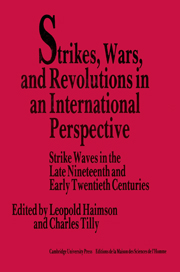 Strikes, Wars, and Revolutions in an International Perspective
Strikes, Wars, and Revolutions in an International Perspective Book contents
- Frontmatter
- Contents
- List of contributors
- Preface
- Part I Introductions
- Part II Models and realities
- Part III Workers in metal-processing enterprises in comparative perspective
- Part IV The effects of short-term variation
- 18 Introduction
- 19 Economic cycles and labor conflicts in Germany during the first quarter of the twentieth century
- 20 The crisis of state and society in Britain, 1917–1922
- 21 Strikes and the war
- 22 Labor unrest in Imperial Russia on the eve of the First World War: the roles of conjunctural phenomena, events, and individual and collective actors
- 23 Strikes in Russia, 1917: the impact of revolution
- Part V Conclusion
20 - The crisis of state and society in Britain, 1917–1922
Published online by Cambridge University Press: 25 March 2010
- Frontmatter
- Contents
- List of contributors
- Preface
- Part I Introductions
- Part II Models and realities
- Part III Workers in metal-processing enterprises in comparative perspective
- Part IV The effects of short-term variation
- 18 Introduction
- 19 Economic cycles and labor conflicts in Germany during the first quarter of the twentieth century
- 20 The crisis of state and society in Britain, 1917–1922
- 21 Strikes and the war
- 22 Labor unrest in Imperial Russia on the eve of the First World War: the roles of conjunctural phenomena, events, and individual and collective actors
- 23 Strikes in Russia, 1917: the impact of revolution
- Part V Conclusion
Summary
When David Lloyd George surveyed the political scene in the famous Fontainebleau memorandum of March 1919, he claimed to discern a “spirit of revolution” in every country in Europe, not excepting Great Britain.
The whole of Europe is filled with the spirit of revolution. There is a deep sense not only of discontent, but of anger and revolt, amongst the workmen against prewar conditions. The whole existing order in its political, social and economic aspects is questioned by the masses of the population from one end of Europe to the other. In some countries, like Germany and Russia, the unrest takes the form of open rebellion; in others, like France, Great Britain and Italy, it takes the shape of strikes and of a general disinclination to settle down to work – symptoms which are just as much concerned with the desire for political and social change as with age demands.
The forces that were toppling regimes and dynasties in central and eastern Europe were thus seen to be active also in Britain. Of course, they were unlikely to have such dramatic effects on the English side of the Channel. And yet neither Lloyd George nor anyone else could doubt that they would bring about far-reaching changes in the nature of British politics and society. Indeed, the extraordinary trajectory of Lloyd George's own political career from 1916 to 1922 is quite incomprehensible to anyone who fails to recognize the essential fluidity and sense of crisis that characterized British political life in that era and that permeated the consciousness, not simply of Lloyd George, but also of the mass of rather dull and ordinary politicians with whom he dealt.
- Type
- Chapter
- Information
- Strikes, Wars, and Revolutions in an International PerspectiveStrike Waves in the Late Nineteenth and Early Twentieth Centuries, pp. 457 - 472Publisher: Cambridge University PressPrint publication year: 1989
- 1
- Cited by
